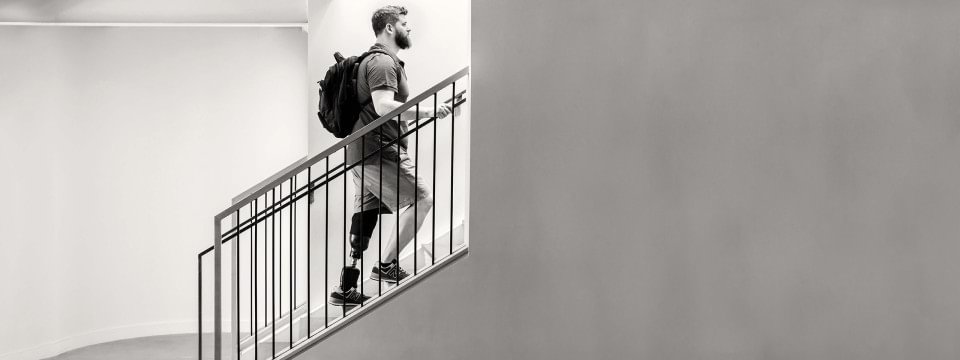Finding the best foot for you
People with lower-limb loss sometimes need a prosthetic leg system with a knee (if they are above-knee amputees) or not, if they are below-knee amputees. Most use liners, and many also use sleeves to add comfort and performance to their leg system. But everybody needs a foot!
New devices open the door to new opportunities and activities for people who need a prosthetic foot. A broad selection of feet, including many that simulate the dynamic action of an anatomical foot, can help you meet your activity goals. There are even feet specifically designed for running.
About feet
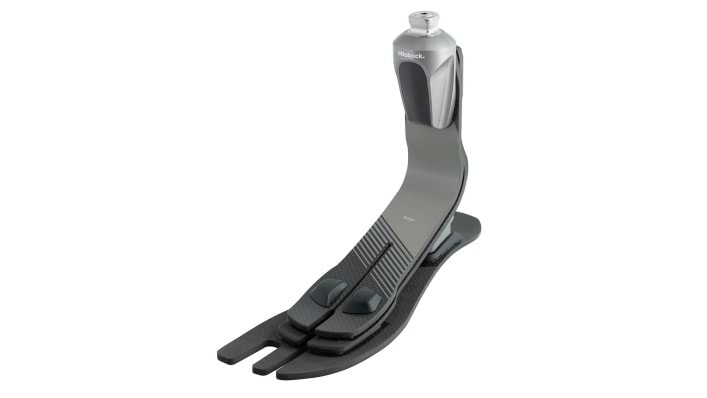
The basics
Designing prosthetic foot systems is challenging. It’s very difficult to reproduce the complex workings of the human foot and ankle. Ideally the foot will be light because its weight is added to the rest of the leg prosthesis. If the foot is too heavy, the suspension system may be affected and with it the connection to the socket and your limb.
A good prosthetic foot should also be strong, as it will be taking on huge force and torque as you walk and run. Feet must also be small enough to fit within a foot shell, a cosmetic covering for the prosthetic foot, and thus fit within a shoe. Being light, strong, and small, and yet functional and durable is the challenge.

Early designs for prosthetic feet were often a solid piece of wood. A similar design, the SACH (solid-ankle-cushioned-heel) is still in use because of its sturdy function, especially useful for individuals with lower activity levels. A SACH foot typically has a rigid inner structure (wood or plastic) surrounded by a compressible foam cosmetic shell.
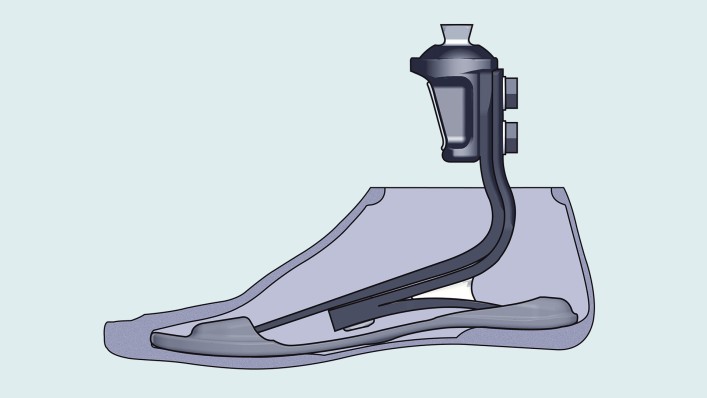
Today’s more sophisticated feet, which add more functions, are secured inside a cosmetic shell. Most people never see their prosthetic foot without this exterior shell. The cosmetic shell, which stretches around the foot prosthesis and is held in place, serves two purposes:
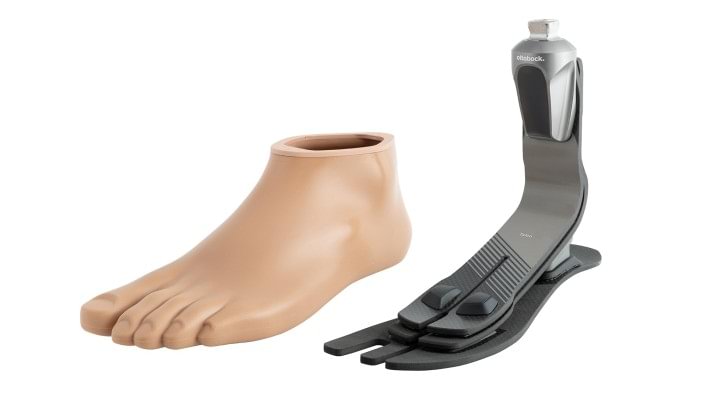
- It makes your foot prosthesis look like an anatomical foot.
- It fills the space in your shoe.
The foot prosthesis
What’s inside the shell can vary dramatically. Prosthetic feet are designed to meet the needs that fit your lifestyle and activity level. Here are some factors to consider.
Materials. The materials in a prosthetic foot differ by activity level. Wood, plastic and foam are usually found in feet designed for individuals who have low activity levels and require stability. Carbon fiber feet meet the functional needs for shock absorption and energy efficiency, and are lightweight as well.
Comfort. A prosthetic foot has to feel good for you to meet your activity goals. Comfort allows you to be more active, and the function of your prosthetic foot directly affects comfort.
Function. Prosthetic feet are designed to mimic a human foot at a specific activity level. For people who cannot walk, the function is largely cosmetic. For those who are most active, a prosthetic foot must mimic a normal foot during the act of walking. It must act as a shock absorber as you strike your heel to the ground, adapt to uneven terrain, provide a smooth rollover from heel to toe, and provide a rigid lever for propelling forward when you finish your step (“toe-off”).
Multi-axial motion. Some prosthetic feet are designed to mimic the ankle, which allows the foot to move in multiple planes. Multi-axial capability in a foot allows you to raise and lower the forefoot; move the forefoot to the left and right; and roll the foot slightly to the inside and to the outside. Multi-axial motion is needed to walk comfortably and confidently on uneven ground, when your foot must adapt to whatever it encounters.
Energy storage. A foot made with carbon fiber for energy storage literally gives you a spring in your step. The carbon fiber acts as a spring, compressing as you apply weight and propelling you forward as your foot rolls, returning energy to your step as the spring releases. Some prostheses have one spring in the heel and a second spring in the forefoot: just what you need for walking at various speeds, running, climbing hills or descending stairs with a secure, confident stride. With carbon fiber, the longer the spring, the more energy it can store and the more responsive the foot will be.
The right foot for you
To find a prosthetic foot to meet your needs, consider:
Your limb loss.
If you still have part of your foot, you probably will need a custom prosthesis that is molded to fit in a shoe. If you experienced an amputation involving the ankle, including ankle-disarticulation, Symes, Chopart, Pirogoff or Boyd surgery, you’ll need a specialized low-profile foot. For an amputation above the ankle, a standard prosthetic foot can meet your needs. You should consider multi-axial capability as well as shock absorption. For above-knee amputees, keep in mind that the higher the limb loss, the less control you will have of the prosthesis and the more you will need stability in your prosthetic foot.Your activity level.
Manufacturers categorize prosthetic feet by the user’s activity level. Selecting a prosthesis that matches your activity level will maximize your mobility and your quality of life. The wrong prosthesis can actually make walking more difficult or less stable for you.If a practitioner or therapist has not yet identified your activity level, here are some very basic indications. If you’re on the border between two activity levels, consider products designed for both levels.
Activity Level 0
If you cannot walk, you may still want a prosthetic foot for your own sense of well-being or to feel more confident in social settings. Because it will not support your weight or help you walk, it doesn’t need any features that aid mobility.
Activity Level 1
For those with the most limited mobility, prosthetic feet designed for maximum stability help maintain balance when standing or taking short, cautious steps at minimal speed on level floors. With safety as a priority, opt for these characteristics in a prosthetic foot:
- Lightweight
- A secure stance area upon heel contact that allows you to safely shift your weight onto the foot
- Allows walking without bending the knee
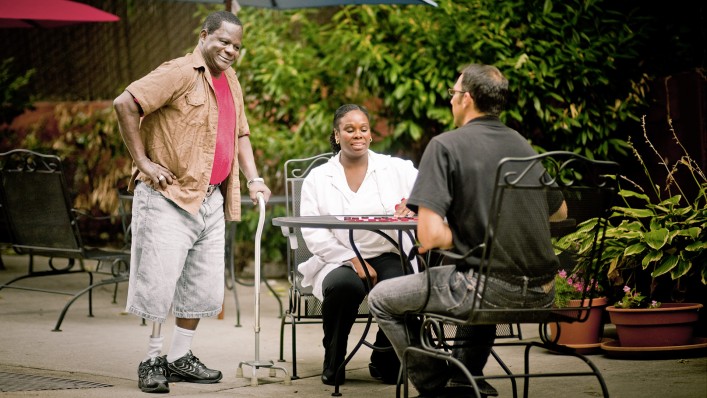
Activity Level 2
To walk for a limited time and limited speed and be able to negotiate obstacles like curbs or uneven ground, you would benefit from a prosthetic foot that offers stability and comfort, meaning it protects the joints and residual-limb tissue. Look for a prosthetic foot that features:
- Shock absorption at heel strike
- A light rollover during walking
- A dynamic transition from standing into swing phase (taking a step)
- Moderate multi-axial functionality, if you expect to walk on uneven ground

Activity Level 3
If you’re a person who can walk at varying speeds while also negotiating uneven terrain and similar barriers, look for these features in a prosthetic foot:
- A smooth rollover as the prosthetic foot transitions from heel strike to toe-off.
- Good energy efficiency.
- Ability to adapt to uneven ground.
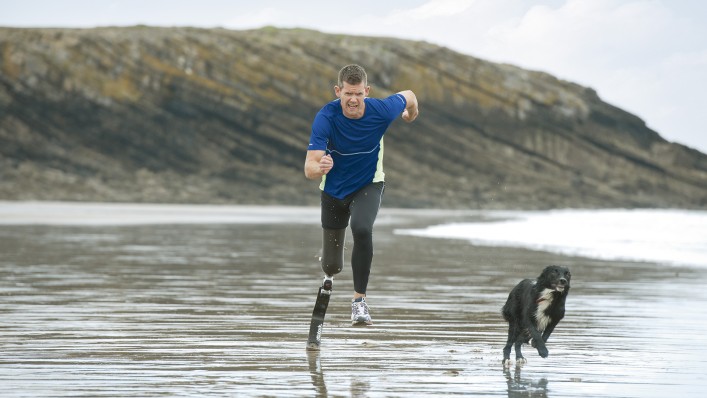
Activity Level 4
For the highest level of mobility, including walking for unlimited time and distance plus demanding work, recreational or athletic activities, you need a prosthetic foot that can withstand shock, tension and torsion and that responds when you change walking speeds or start running. (For certain activities, you might consider additional specialty feet for sports or swimming.)
For everyday use, look for a prosthetic foot with:
- An easy rollover
- Good forefoot support
- Excellent energy efficiency. Consider a carbon-fiber foot with more stiffness for support and energy storage.
- Ability to adapt to uneven ground
Your weight.
Prosthetic feet are designed for a specific weight range. To ensure that a prosthetic foot performs well for you, choose one suited to your weight class.Your clearance.
When you stand, a prosthesis fills the space between your residual limb and the floor. It is designed to add only the length needed to equal your other leg. Most prosthetic feet are 2 to 7 inches in height. Consequently, a limb loss near the ankle may limit your options to low-profile prosthetic feet.Your preferred shell.
Shells can be ordered in colors to match skin tone, in a range of sizes and often with a split toe for wearing sandals. Low-end shells may lack detail, such as toes, and may be attached to the prosthetic foot. At the high end, the toes and skin colors are more realistic. If your activity level is 3 or 4, look for a foot with a shell that can be replaced if you wear it out dancing or playing tennis.Price.
The price of prosthetic feet generally rises with the activity level because additional functionality translates to more structure and more expensive materials. Reimbursement by an insurance company or government program depends on specific codes. Before making a final selection, make sure the prosthetic foot of your choice is covered. Insurance companies often will cover a more expensive prosthesis if it will enable you to increase your activity level, work a longer day or take fewer days off.Downloads

- Ottobock Foot Portfolio Flyer 580.67 kB | PDF
Foot Portfolio Flyer
FAQs
Take a look at our Frequently Asked Questions for more information.
-
How do I get the cost of a prosthetic foot covered?
There are many ways to cover the cost. Check out the Financial Coverage section of this website.
-
How do I choose the right foot?
Your health care team will work closely with you to make the decision, based on your activity goals and lifestyle. Often you will be able to try out a foot in your prosthetist’s office to see if it’s right for you.
Not finding what you are looking for? Please contact us!
